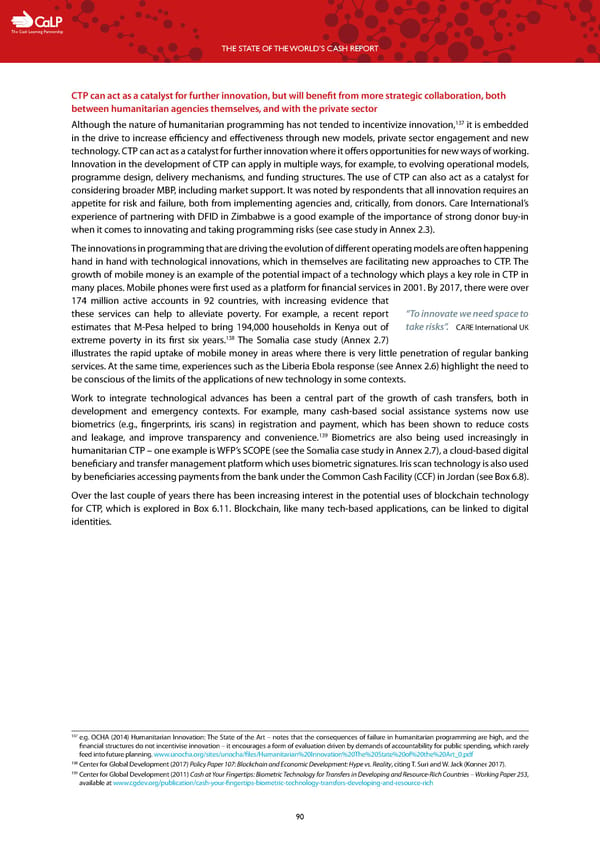C The Cash Learning Partnership THE STATE OF THE WORLD’S CASH REPORT CTP can act as a catalyst for further innovation, but will benefit from more strategic collaboration, both between humanitarian agencies themselves, and with the private sector Although the nature of humanitarian programming has not tended to incentivize innovation,137 it is embedded in the drive to increase efficiency and effectiveness through new models, private sector engagement and new technology. CTP can act as a catalyst for further innovation where it offers opportunities for new ways of working. Innovation in the development of CTP can apply in multiple ways, for example, to evolving operational models, programme design, delivery mechanisms, and funding structures. The use of CTP can also act as a catalyst for considering broader MBP, including market support. It was noted by respondents that all innovation requires an appetite for risk and failure, both from implementing agencies and, critically, from donors. Care International’s experience of partnering with DFID in Zimbabwe is a good example of the importance of strong donor buy-in when it comes to innovating and taking programming risks (see case study in Annex 2.3). The innovations in programming that are driving the evolution of different operating models are often happening hand in hand with technological innovations, which in themselves are facilitating new approaches to CTP. The growth of mobile money is an example of the potential impact of a technology which plays a key role in CTP in many places. Mobile phones were first used as a platform for financial services in 2001. By 2017, there were over 174 million active accounts in 92 countries, with increasing evidence that these services can help to alleviate poverty. For example, a recent report “To innovate we need space to estimates that M-Pesa helped to bring 194,000 households in Kenya out of take risks”. CARE International UK 138 extreme poverty in its first six years. The Somalia case study (Annex 2.7) illustrates the rapid uptake of mobile money in areas where there is very little penetration of regular banking services. At the same time, experiences such as the Liberia Ebola response (see Annex 2.6) highlight the need to be conscious of the limits of the applications of new technology in some contexts. Work to integrate technological advances has been a central part of the growth of cash transfers, both in development and emergency contexts. For example, many cash-based social assistance systems now use biometrics (e.g., fingerprints, iris scans) in registration and payment, which has been shown to reduce costs 139 and leakage, and improve transparency and convenience. Biometrics are also being used increasingly in humanitarian CTP – one example is WFP’s SCOPE (see the Somalia case study in Annex 2.7), a cloud-based digital beneficiary and transfer management platform which uses biometric signatures. Iris scan technology is also used by beneficiaries accessing payments from the bank under the Common Cash Facility (CCF) in Jordan (see Box 6.8). Over the last couple of years there has been increasing interest in the potential uses of blockchain technology for CTP, which is explored in Box 6.11. Blockchain, like many tech-based applications, can be linked to digital identities. 137 e.g. OCHA (2014) Humanitarian Innovation: The State of the Art – notes that the consequences of failure in humanitarian programming are high, and the financial structures do not incentivise innovation – it encourages a form of evaluation driven by demands of accountability for public spending, which rarely feed into future planning. www.unocha.org/sites/unocha/files/Humanitarian%20Innovation%20The%20State%20of%20the%20Art_0.pdf 138 Center for Global Development (2017) Policy Paper 107: Blockchain and Economic Development: Hype vs. Reality, citing T. Suri and W. Jack (Konner 2017). 139 Center for Global Development (2011) Cash at Your Fingertips: Biometric Technology for Transfers in Developing and Resource-Rich Countries – Working Paper 253, available at www.cgdev.org/publication/cash-your-fingertips-biometric-technology-transfers-developing-and-resource-rich 90
 The State of the World's Cash | Full Report Page 91 Page 93
The State of the World's Cash | Full Report Page 91 Page 93